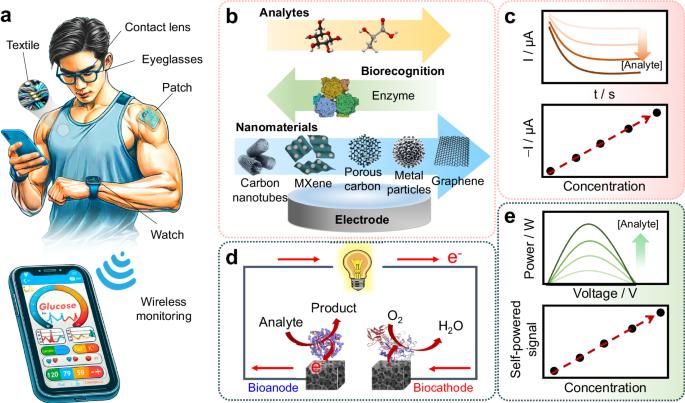Synergistic convergence of materials and enzymes for biosensing and self-sustaining energy devices towards on-body health monitoring
IF 7.5
Q1 MATERIALS SCIENCE, MULTIDISCIPLINARY
引用次数: 0
Abstract
Wearable enzyme-based biosensors enable advanced healthcare diagnostics through the monitoring of biomarkers and physiological states. The integration of materials engineering and enzyme conjugation has established the groundwork for advancements in modern analytical chemistry, poised to extend the frontiers of wearable biosensing further. Recent advancements in enzymatic biofuel cells have also enhanced devices by harnessing biofuels, such as glucose and lactate in biofluids. Importantly, biofuel cells offer the potential for self-powered biosensors. Here, we present an overview of the principles and considerations associated with engineering materials and integrating enzymes with electrodes to achieve effective wearable biosensing and self-sustaining biofuel cell-based energy systems. Furthermore, we discuss challenges encountered by enzymatic sensors and biofuel cells. Representative applications of wearable devices in healthcare settings are highlighted, along with a summary of real sample analyses, emphasizing the concentration ranges of analytes present in actual sweat samples to underscore their relevance in real-world scenarios. Finally, the discussion explores the anticipated impact of future material innovations and integrations on the development of next-generation wearable biodevices. Enzyme-based wearable biosensors offer a unique approach for biomarker detection. This Review discusses recent progress in enzymatic biosensors and biofuel cells, where biofuels self-power the device while enzymes concurrently work for biomarker detection.


材料与酶的协同融合,用于生物传感和自持能源设备,实现人体健康监测
基于酶的可穿戴生物传感器可通过监测生物标志物和生理状态实现先进的医疗诊断。材料工程与酶结合为现代分析化学的发展奠定了基础,有望进一步拓展可穿戴生物传感的领域。酶生物燃料电池的最新进展还通过利用生物流体中的葡萄糖和乳酸等生物燃料增强了设备的功能。重要的是,生物燃料电池为自供电生物传感器提供了潜力。在此,我们概述了与工程材料和将酶与电极集成相关的原理和注意事项,以实现有效的可穿戴生物传感和基于生物燃料电池的自我维持能源系统。此外,我们还讨论了酶传感器和生物燃料电池所遇到的挑战。我们还重点介绍了可穿戴设备在医疗保健领域的代表性应用,并总结了实际样本分析,强调了实际汗液样本中分析物的浓度范围,以突出它们在现实世界中的相关性。最后,讨论探讨了未来材料创新和集成对开发下一代可穿戴生物设备的预期影响。
本文章由计算机程序翻译,如有差异,请以英文原文为准。
求助全文
约1分钟内获得全文
求助全文
来源期刊

Communications Materials
MATERIALS SCIENCE, MULTIDISCIPLINARY-
CiteScore
12.10
自引率
1.30%
发文量
85
审稿时长
17 weeks
期刊介绍:
Communications Materials, a selective open access journal within Nature Portfolio, is dedicated to publishing top-tier research, reviews, and commentary across all facets of materials science. The journal showcases significant advancements in specialized research areas, encompassing both fundamental and applied studies. Serving as an open access option for materials sciences, Communications Materials applies less stringent criteria for impact and significance compared to Nature-branded journals, including Nature Communications.
文献相关原料
| 公司名称 | 产品信息 | 采购帮参考价格 |
|---|
 求助内容:
求助内容: 应助结果提醒方式:
应助结果提醒方式:


